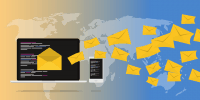What Is Blog Security: Hacking And Cyber Attacks

Blog security is a critical aspect of maintaining a safe and trustworthy online presence. As the popularity of blogs continues to rise, so does the risk of hacking and cyber attacks. These threats can compromise the integrity of the blog, expose sensitive information, and damage the reputation of the blogger. Therefore, it is crucial to understand the importance of blog security and take appropriate measures to protect against potential threats.
This article aims to provide an objective and impersonal overview of blog security, focusing on the various strategies and practices that bloggers can implement to safeguard their blogs from hacking and cyber attacks. It will explore common cyber threats faced by bloggers, such as malware and viruses, and discuss preventive measures like implementing strong passwords and user authentication.
Additionally, the article will emphasize the significance of regularly updating and patching blog software, backing up data, using secure hosting and SSL certificates, and monitoring and responding to suspicious activity. By following these practices, bloggers can ensure the security and longevity of their online platforms.
Key Takeaways
- Understanding common cyber threats like malware, phishing, and DDoS attacks is important.
- Implementing strong passwords and user authentication enhances blog security.
- Regularly updating and patching blog software helps prevent security breaches.
- Backing up blog data regularly protects against data loss and enables quick recovery.
Importance of Blog Security
The significance of blog security lies in its ability to safeguard against unauthorized access, data breaches, and potential damage inflicted by cyber attacks.
Blogs have become an essential platform for individuals and organizations to share valuable information and engage with their audience. However, this increased online presence also attracts malicious actors who seek to exploit vulnerabilities in blog platforms.
Implementing robust security measures helps protect sensitive information, such as user data and intellectual property, from unauthorized disclosure or theft.
Additionally, blog security plays a crucial role in maintaining the trust and credibility of the blog owner or organization. A successful cyber attack can lead to reputational damage, loss of audience trust, and financial implications.
By prioritizing blog security, individuals and organizations can mitigate the risks associated with hacking and cyber attacks, ensuring the integrity and confidentiality of their blog content.
Understanding Common Cyber Threats
Understanding common cyber threats requires knowledge of various techniques used by hackers and the vulnerabilities they exploit. It is crucial for bloggers to be aware of these threats in order to protect their blogs effectively.
Here are three common cyber threats that bloggers should be familiar with:
- Malware: Malicious software that hackers use to gain unauthorized access to a blog’s system, steal sensitive information, or disrupt its functionality.
- Phishing: A technique where hackers attempt to trick bloggers into revealing their login credentials or personal information by posing as a trustworthy entity.
- DDoS Attacks: Distributed Denial of Service attacks overwhelm a blog’s server with a flood of traffic, causing it to become unresponsive and inaccessible to legitimate users.
By understanding these common cyber threats, bloggers can take proactive measures to protect their blogs and ensure a secure online environment for themselves and their audience.
Implementing Strong Passwords and User Authentication
Implementing strong passwords and user authentication is crucial for bloggers to ensure the security and integrity of their online platforms. Passwords act as the first line of defense against unauthorized access to a blog.
It is important to create passwords that are complex and unique, combining a mix of uppercase and lowercase letters, numbers, and special characters. Additionally, bloggers should avoid using easily guessable information such as their name, birthdate, or common dictionary words.
Enforcing regular password updates and limiting the number of login attempts can further enhance security. User authentication methods such as two-factor authentication add an extra layer of protection by requiring users to provide additional verification, such as a unique code sent to their mobile device.
By implementing strong passwords and user authentication measures, bloggers can significantly reduce the risk of cyber attacks and protect their blog from potential security breaches.
Regularly Updating and Patching Your Blog’s Software
Regularly updating and patching a blog’s software is essential for maintaining the integrity and functionality of the platform, as it ensures that any vulnerabilities or bugs are addressed and resolved in a timely manner. This proactive approach helps to prevent potential security breaches and cyber attacks that could compromise sensitive information or disrupt the blog’s operation.
By regularly updating the software, the blog owner or administrator can take advantage of the latest security patches and fixes provided by the software developers. This helps to close any known security loopholes and strengthens the overall security posture of the blog.
Additionally, updating the software also ensures compatibility with newer technologies and plugins, enabling the blog to stay relevant and up-to-date.
To emphasize the importance of regular software updates, here is a bullet list:
- Regular updates address vulnerabilities and bugs
- Proactive approach prevents security breaches
- Latest security patches and fixes are implemented
- Known security loopholes are closed
- Compatibility with newer technologies and plugins is maintained.
Backing Up Your Blog’s Data Regularly
Backing up a blog’s data regularly is crucial for safeguarding valuable information and ensuring the ability to restore the blog in the event of data loss or system failure. By creating regular backups, bloggers can protect their content, prevent permanent data loss, and minimize the impact of cyber attacks. Backing up blog data involves making copies of all files, including text, images, and databases, and storing them in a secure location.
This practice provides an additional layer of security against hacking attempts, malware infections, or accidental deletions. Moreover, it allows bloggers to recover their content quickly and efficiently, reducing downtime and minimizing the potential negative effects on their audience. In summary, backing up blog data regularly is an essential security measure that every blogger should prioritize.
| Advantages of Regular Data Backups | |||
|---|---|---|---|
| Protection against data loss | Quick recovery from system failures | Prevention of permanent data loss | |
| Defense against cyber attacks | Minimization of downtime | Enhanced protection of sensitive information and personal data |
Regular data backups serve as an essential security measure that every blogger should prioritize because they enhance the protection of sensitive information and personal data. By regularly backing up their data, bloggers can ensure that their important files, articles, and website content are securely stored and can be quickly recovered in the event of system failures, permanent data loss, or cyber attacks. This practice minimizes downtime and promotes a quick recovery process, allowing bloggers to resume their work without significant disruption.
Protecting Against Malware and Viruses
Malware and viruses pose significant threats to the integrity and functionality of a blog’s data, necessitating robust measures to safeguard against these harmful entities. These malicious software programs can infiltrate a blog’s system through various means, such as infected files, email attachments, or malicious links.
Once inside, they can wreak havoc by stealing sensitive information, corrupting data, or disrupting the blog’s overall functionality. To protect against malware and viruses, it is crucial to install and regularly update reliable antivirus software. This software scans the system for any malicious code and eliminates it before it can cause any harm.
Additionally, implementing a web application firewall can help block malicious traffic and prevent unauthorized access. Regularly scanning the blog’s files and plugins for any suspicious activity and promptly updating them can also minimize the risk of malware infections.
By adopting these preventive measures, blog owners can mitigate the potential damage caused by malware and viruses and ensure the security of their valuable data.
Using Secure Hosting and SSL Certificates
Using secure hosting and SSL certificates is essential for ensuring the safety and integrity of a blog’s data and protecting against potential threats.
Secure hosting refers to a hosting provider that implements robust security measures, such as firewalls, intrusion detection systems, and regular security updates. By choosing a reputable hosting provider, bloggers can minimize the risk of unauthorized access to their blog’s backend and sensitive information.
SSL (Secure Sockets Layer) certificates, on the other hand, encrypt the data transmitted between a blog and its visitors’ browsers, making it difficult for hackers to intercept and decipher the information. SSL certificates also provide authentication, assuring visitors that they are interacting with the legitimate blog and not an imposter.
Therefore, implementing secure hosting and SSL certificates is crucial in safeguarding a blog from hacking and cyber attacks.
Monitoring and Responding to Suspicious Activity
Monitoring and promptly responding to suspicious activity is a crucial practice in ensuring the integrity and safety of a blog’s data, as it allows for the timely detection and mitigation of potential threats. By actively monitoring the blog’s traffic, access logs, and user activity, blog owners can identify any abnormal patterns or unauthorized access attempts. This proactive approach enables them to take immediate action and implement necessary security measures to protect their blog from hacking and cyber attacks.
Along with monitoring, having a well-defined incident response plan is essential. This plan outlines the steps to be taken in case of a security breach, including assessing the impact, containing the incident, and restoring the blog’s functionality. By following these practices, blog owners can enhance their blog’s security posture and safeguard their valuable data.
| Benefits of Monitoring and Responding to Suspicious Activity | Challenges of Monitoring and Responding to Suspicious Activity | |||
|---|---|---|---|---|
| Early detection and mitigation of potential threats | False positives can lead to unnecessary alerts | |||
| Enhanced protection of blog’s data and integrity | Requires dedicated time and resources for continuous monitoring | |||
| Timely implementation of security measures | Identifying sophisticated attacks can be challenging | Effective training and education on cybersecurity best practices | is crucial for minimizing the risk of successful attacks. |
Frequently Asked Questions
How can I protect my blog from social engineering attacks?
To protect a blog from social engineering attacks, several measures can be taken. These include implementing strong password policies, regularly updating software and plugins, educating users about phishing techniques, and implementing two-factor authentication to enhance security.
What are some best practices for securing my blog’s server?
Some best practices for securing a blog’s server include regularly updating the server software, implementing strong access controls, using secure communication protocols, conducting regular security audits, and keeping backups of the blog’s data.
Are there any specific security measures I should take for my blog’s comments section?
Specific security measures for a blog’s comments section include implementing a robust comment moderation system, utilizing CAPTCHA or other anti-spam measures, regularly updating the commenting platform, and configuring strict user authentication protocols to prevent unauthorized access and potential security breaches.
What steps can I take to prevent unauthorized access to my blog’s admin panel?
To prevent unauthorized access to a blog’s admin panel, there are several steps that can be taken. These include using strong and unique passwords, enabling two-factor authentication, keeping software and plugins up to date, and regularly monitoring access logs for any suspicious activity.
How can I ensure the security of my blog’s plugins and themes?
Ensuring the security of a blog’s plugins and themes involves regularly updating and patching them to address any vulnerabilities. Additionally, using reputable sources, scanning for malware, and implementing strong access controls can further enhance the security measures.






